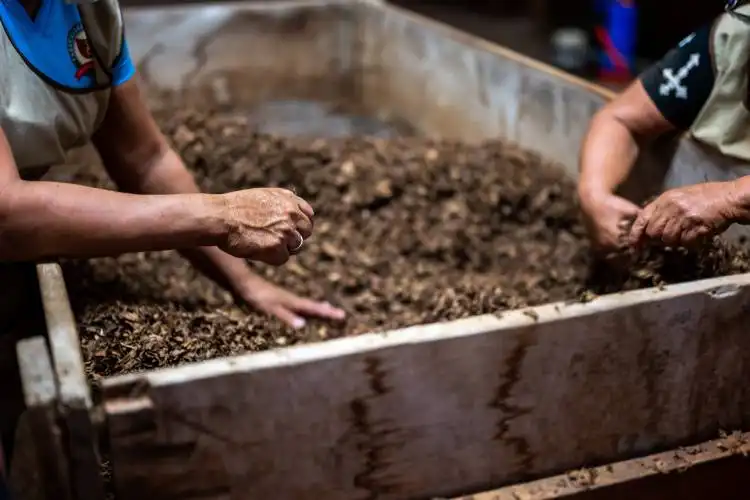Start a Cactus Leather Business
Venturing Into The Eco-Friendly and Fashionable World of Cactus Leather
| Updated


CACTUS LEATHER BUSINESS
Picture this: a business switch so trendy and eco-friendly all at once. Welcome to the cactus leather business! This innovative enterprise thrives on transforming prickly cactus plants into smooth, durable leather. It's a charming and ingenious way of producing a sustainable leather alternative, saving cows and pleasing fashionistas and environmentalists at once. Buckle up green entrepreneurs, your venture into ethical fashion is about to spiky, prickly, and utterly fascinating!
Jump to Business Plan
RELATED BUSINESS IDEAS
Browse ALL Sustainability & Eco-Friendly Initiatives Business Ideas
Discover Your Perfect Domain
Unlock the door to your online success with our hand-picked selection of premium domain names. Whether you're starting a new venture or rebranding an existing one, the right domain can set the tone for your digital presence. Browse through our curated list, each with its unique potential to enhance your brand's visibility and credibility.
CACTUS LEATHER MINI BUSINESS PLAN
This a quick reality check to help you identify the strengths and weaknesses of your business concept before you dive in.
Business Idea: Cactus Leather
Expected Percent Margin:
- Gross Margin: 45-60%
- Net Profit Margin: 15-25%
Earnings Expectations:
- Daily Earnings: $150 - $400
- Weekly Earnings: $1,050 - $2,800
- Monthly Earnings: $4,500 - $12,000
- Annual Earnings: $54,000 - $144,000
Actions to Hit Those Numbers:
Product Sourcing and Management:
- Initial Investment: Start-up costs will be between $10,000 and $20,000, primarily for product creation and procurement.
- Supplier Relationship: You need to establish a link with a reliable cactus supplier and invest in eco-friendly processing equipment.
Marketing and Customer Acquisition:
- Online Presence: Develop a strong online presence through industry-specific platforms and social media. Post engaging content 3-4 times a week.
- Partnerships: Collaborate with fashion brands, shoemakers, and handbag designers to integrate your cactus leather into their products.
Sales and Customer Experience:
- Product Pricing: The unique and eco-friendly aspects of your product should be reflected in your pricing. Price your items competitively to attract interest while ensuring profitability.
- Customer Service: Invest in good customer service to ensure repeat business and positive referrals.
Cost Control:
- Production Costs: Aim to keep cost of goods sold (COGS) under 35-40% of your selling price. Keep production local to reduce costs and oversee quality.
Business Operations:
- Ongoing Product Development: Experiment with textures, colors, and other differentiators to continually evolve your product offerings.
- Direct Sales & Wholesale: Start with direct sales online, then expand to wholesale to fashion producers and designers once you have steady production.
Remember, these are rough estimates and can vary significantly based on a multitude of factors, including location and market demand. Our numbers are intended to provide a ballpark perspective and are not a guarantee of earnings.
NOT WHAT YOU HAD IN MIND? Here are more ideas



Browse ALL Sustainability & Eco-Friendly Initiatives Business Ideas
Grab Your Business Website Name
Before you get caught up in the whirlwind of setting up your business, invest in a domain name. It's a small but significant step that lays the foundation for your brand and makes it easier for customers to find and trust you. Just like you wouldn't build a house without securing the land first, don't build a business without securing your domain name.
"Why? Can't that wait?" Here's why it shouldn't
Step 1: Determine if the Business is Right Endeavor
Breakdown of Startup Expenses
When starting a cactus leather business, it is important to consider the startup expenses. These expenses can include the cost of purchasing cactus leather, the cost of any necessary equipment, the cost of any necessary licenses or permits, and the cost of any necessary advertising or marketing. It is also important to consider any additional costs such as insurance, taxes, and legal fees. Additionally, it is important to factor in the cost of any labor that may be needed to help with the business. Taking the time to carefully consider all of these expenses will help to ensure that the business is financially viable.
Breakdown of Ongoing Expenses
In addition to startup expenses, it is important to consider the ongoing expenses associated with a cactus leather business. These expenses can include the cost of purchasing cactus leather, the cost of any necessary equipment, the cost of any necessary licenses or permits, and the cost of any necessary advertising or marketing. Additionally, it is important to consider the cost of any labor that may be needed to help with the business, as well as any additional costs such as insurance, taxes, and legal fees. Carefully considering all of these expenses will help to ensure that the business is financially viable in the long-term.
Examples on Ways to Make Money
There are a variety of ways to make money with a cactus leather business. One of the most common ways is to sell the cactus leather directly to customers. This can be done through an online store, a brick-and-mortar store, or through a combination of both. Additionally, cactus leather can be used to create a variety of products such as wallets, bags, and belts, which can then be sold to customers. Finally, cactus leather can also be used to create custom designs, which can be sold to customers as well. By carefully considering all of these potential sources of income, it will be easier to determine if the business is a viable endeavor.
Step 2: Name the Business
When naming a business, it is important to choose a name that is memorable, unique, and reflects the business’s mission. It is also important to make sure that the name is not already in use by another business. A good way to start brainstorming is to think of words that are related to cactus leather, such as “suede”, “hide”, “leather”, “cacti”, and “desert”. Additionally, it is important to make sure that the name is easy to spell and pronounce. It is also helpful to create a logo or tagline that can be used to help promote the business. Once the business name has been chosen, it is important to register the business with the local government and to make sure that the name is not trademarked by another business. This can be done by searching the US Patent and Trademark Office database. Additionally, it is important to make sure that the business name is available as a domain name and that the social media accounts associated with the business name are available.
Step 3: Obtain Necessary Licenses and Permits
The third step in starting a cactus leather business is to obtain the necessary licenses and permits. Depending on the location of the business, there may be a variety of licenses and permits required. For example, a business license may be required to operate, as well as a sales tax permit. Additionally, a business may need to obtain a permit to use hazardous materials, such as chemicals used in the tanning process. It is important to research the local regulations and obtain the necessary permits before beginning operations.
In addition to local permits, businesses may need to obtain federal permits, such as a trademark or copyright. A trademark or copyright can help protect the business’s name, logo, and other intellectual property. To obtain a trademark or copyright, the business must file an application with the United States Patent and Trademark Office.
Finally, businesses may need to obtain an environmental permit if they are using hazardous materials in the tanning process. This permit will help ensure that the business is following all environmental regulations and is not polluting the environment. It is important to research the local regulations and obtain the necessary permits before beginning operations.
Step 4: Secure a Location
Securing a location for your cactus leather business is an important step in the process. You will need to consider the size of the space, the cost of rent, and the availability of utilities. It is important to find a space that is large enough to accommodate the necessary equipment, materials, and staff. You may also need to consider the location of the business in relation to your target customers. If you plan to sell online, you may not need to worry about this. However, if you plan to open a physical store, you will need to find a location that is convenient for customers. Additionally, you will need to consider the zoning regulations in your area and make sure that your business is compliant. Finally, you will need to secure the necessary permits and licenses to operate your business legally.
Step 5: Source Suppliers
Once you have determined the type of cactus leather you want to use, you need to source suppliers. You can find suppliers through online marketplaces, such as Alibaba, or by searching for local suppliers. When sourcing suppliers, it is important to research their reputation and quality of their products. You should also compare prices to ensure you are getting the best deal. Additionally, it is important to consider the shipping costs associated with each supplier. Once you have identified a few potential suppliers, you should contact them directly to discuss pricing and delivery options. It is also important to ensure that the supplier is able to meet your minimum order requirements. Finally, you should also inquire about any additional services they offer, such as customization or branding.
Step 6: Create a Business Plan
Creating a business plan is an important step in starting a cactus leather business. A business plan should include a detailed description of the business, its goals, and the strategies for achieving those goals. It should also include a financial plan, which should include a breakdown of startup expenses, ongoing expenses, and potential sources of income. Additionally, it should include a marketing plan, which should include a description of the target market, a description of the products and services offered, and a plan for reaching the target market. Finally, the business plan should include a plan for managing the business, which should include a description of the organizational structure, a description of the roles and responsibilities of each team member, and a plan for managing the day-to-day operations.
Step 7: Secure Funding
Securing funding is an important step in starting a cactus leather business. There are several potential sources of funding, such as personal savings, bank loans, venture capital, and crowdfunding. Before pursuing any of these options, it is important to research the different types of funding available and determine which one is best suited for the business. Additionally, it is important to create a detailed budget and financial plan that outlines the expected startup and ongoing expenses. This will help potential investors understand the business and make an informed decision about whether to invest.
Step 8: Purchase Equipment and Supplies
Once the funding is secured, the next step is to purchase the necessary equipment and supplies for the cactus leather business. This should include items such as leather cutting tools, sewing machines, and other materials. Additionally, it is important to research suppliers and compare prices to ensure that the best deals are being secured. It is also important to consider the quality of the materials being purchased, as this will have an impact on the quality of the finished products.
Step 9: Market and Sell the Products
The final step in starting a cactus leather business is to market and sell the products. This should include creating a website and social media accounts to promote the business and its products. Additionally, it is important to create a pricing strategy that is competitive and attractive to potential customers. Additionally, it is important to consider ways to reach the target market, such as participating in trade shows and offering discounts or promotions. Finally, it is important to develop a customer service strategy to ensure that customers are satisfied with their purchases.
Step 7: Market the Business
Once the business is up and running, it is important to market the business to potential customers. This can be done through a variety of methods, such as creating a website, utilizing social media, and attending trade shows. It is also important to create a brand identity for the business, which can be done through creating a logo and designing business cards. Additionally, it is important to create a presence in the local community by attending events and networking with other businesses. Finally, it is important to create a pricing strategy that is competitive and attractive to customers.
Step 8: Develop a Financial Plan
Creating a financial plan is essential for any business, and a cactus leather business is no exception. It's important to have a plan for both startup and ongoing expenses. To start, calculate the cost of the equipment and materials needed to begin production. This includes the cost of the cactus leather, any tools or machines needed to process it, and the cost of any other supplies. Additionally, consider the cost of any marketing materials and advertising needed to promote the business.
Next, consider the ongoing expenses associated with running the business. This includes the cost of labor, rent, utilities, and any other necessary expenses. Additionally, factor in the cost of any materials needed to keep production going. Finally, consider the cost of any taxes associated with the business, as well as the cost of any insurance needed to protect the business.
Once the expenses have been calculated, it's important to consider ways to make money. Consider the cost of the cactus leather and the cost of production, and determine a price point that will make the business profitable. Additionally, consider any other ways to make money, such as selling other products or services, or offering custom orders. Finally, consider any potential partnerships that could help the business grow.
Step 9: Launch the Business
Launching a business can be an exciting and nerve-wracking experience. To ensure the launch goes smoothly, it is important to plan ahead and have a strategy in place. Start by creating a launch plan that outlines the steps you will take to get the business off the ground. This plan should include a timeline for when you will launch, how you will promote the business, and what resources you will need to get started. Additionally, it is important to have a budget in place to cover any costs associated with the launch. Once the plan is in place, it is time to start promoting the business and getting the word out. Utilize social media platforms, email campaigns, and other marketing strategies to spread the word about the business. Additionally, consider partnering with influencers or other businesses to help spread the word. Finally, be sure to have a website and other online presence set up so potential customers can easily find the business.
EXPLORE MORE CATEGORIES
Browse ALL Business Idea Categories
TAKE THE NEXT STEPS










